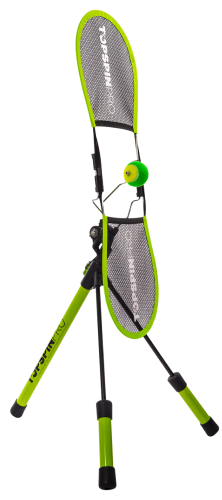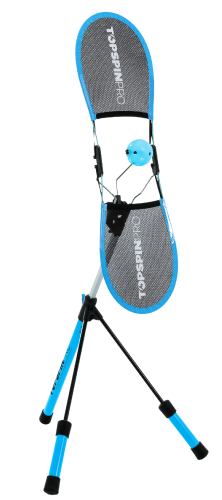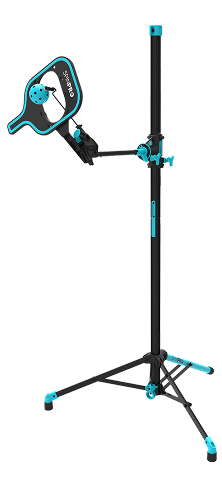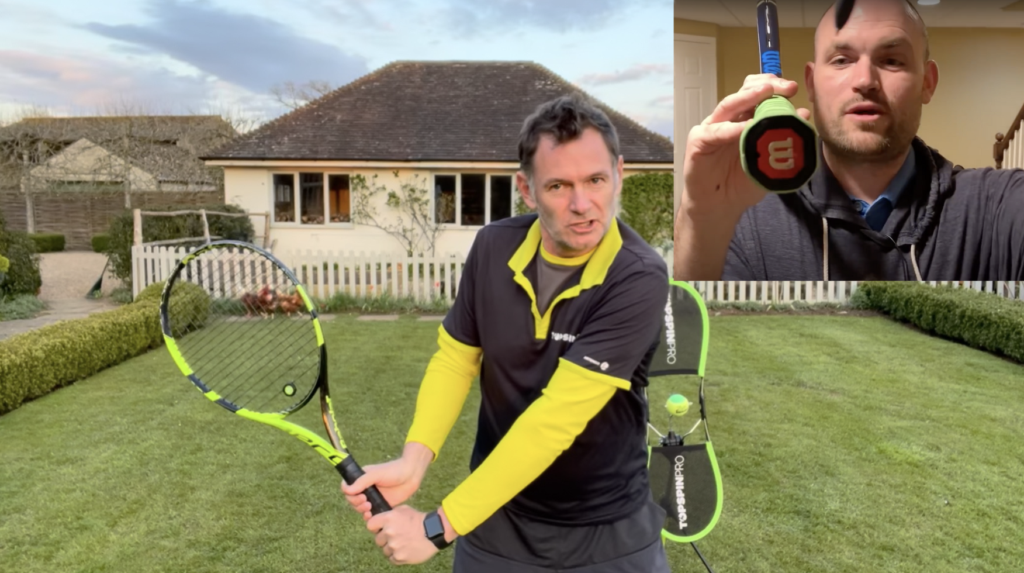Während einer Partie im Jahr 2021 lag ich mit einem Matchball zurück. Ich bin entschlossen, im Spiel zu bleiben. Dann spielt er ihn unweigerlich auf meine Rückhand...
Ich war das ganze Match über damit durchgekommen - gelegentlich schlug ich eine solide Rückhand, lief um sie herum oder verließ mich auf einen Slice, um zu überleben. Aber wenn es darauf ankam, unter Druck, ließ mich meine Rückhand unweigerlich im Stich: Sie traf das Band, segelte weit oder ich umrahmte sie.
Ich hatte die Nase voll. Mein Vertrauen in meine Rückhand war dahin, und ich brauchte dringend einen zuverlässigen Schlag. Jahrelang hatte ich anderen zuversichtlich gesagt : "Kaufen Sie einen TopspinPro und verändern Sie Ihr Tennis". Doch ich wusste aus erster Hand, dass das leichter gesagt als getan war. Um wirklich zu verstehen, was unsere Kunden erlebten, beschloss ich, dass es an der Zeit war, den Weg zu gehen. Ich musste mich auf diesen einen Aspekt meines Spiels konzentrieren, um mich deutlich zu verbessern und eine dauerhafte Veränderung zu erreichen.
Wenn er funktionierte, hatte er eine ordentliche Power und viel Spin, aber meine Rückhand war nie zuverlässig. Ohne einen Loop fehlte den Stop-Start-Bewegungen meines Schlägers die Geschmeidigkeit von Zverev und Djokovic. Und die mühelose Beschleunigung, die ihre höheren Rückschläge erzeugen. Ich hatte es schon einmal versucht, ohne Erfolg. Dieses Mal würde es anders sein.
Die Wissenschaft der dauerhaften Veränderung: Eine systematische Herangehensweise
Ich habe Ideen aus dem Buch "Muscle Memory and Imagery " von Archie Dan Smithübernommen: Besseres Tennis " (das mich später dazu inspirierte, tiefer in das Thema"Beschleunigtes Lernen im Tennis" einzutauchen)
- Tägliche Wiederholungen - Durch konsequentes tägliches Üben wird das Muskelgedächtnis schneller aufgebaut.
- Konzentration auf eine Sache - Die Konzentration auf eine einzige Fähigkeit beschleunigt das Lernen erheblich.
- Fehler zulassen - Fehler sind wichtige Feedback-Schleifen, die helfen, die Technik zu verfeinern.
In jahrelangen Gesprächen mit unseren Kunden habe ich festgestellt, dass die besten Veränderungen durch tägliches, bewusstes Üben erreicht werden. Sich also 21 Tage lang ausschließlich auf meine Rückhand zu konzentrieren, schien mir die richtige Zeitspanne zu sein, um durch ausreichende Wiederholungen dauerhafte Verbesserungen zu erzielen.
Außerdem wollte ich mir nur maximal 10 bis 20 Minuten pro Tag erlauben - ich wollte meinen Ansatz realistisch gestalten. Mit anderen Worten: etwas, das Menschen mit Vollzeitjobs und begrenzter Freizeit umsetzen können.
James Clear von Atomic Habits empfiehlt, beim Aufbau von Gewohnheiten Wege zur Verringerung der Reibung zu finden. Mein Äquivalent zu "die Sportsachen am Vorabend an die Tür stellen" war also das Verlassen des TopspinPro dauerhaft im Flur aufgestellt, so dass ich jedes Mal, wenn ich daran vorbeikam, ein oder zwei Minuten trainieren konnte. (Charlotte war begeistert 😊).
Mein Trainingsplan für die Rückhand:
- Erstens - Aufbau der richtigen Technik mit statischen Ballübungen mit dem TopspinPro, Wiederholung bis sich der Schlag natürlich anfühlt(gefühlsbasiertes Feedback)
- Zweitens - Übergang zu Live-Ballübungen mit der Slinger-Ballmaschine, die realistische Übungsbedingungen gewährleisten(ergebnisorientiertes Feedback)
Um mich selbst zur Rechenschaft zu ziehen, habe ich auf Instagram meine 21-tägige Rückhandtransformation angekündigt ...
Ich hatte einen klaren Fahrplan. Aber dann...
Auftritt Ryan Reidy von 2minutetennis.net...
Ryan entdeckte meinen Beitrag und bot mir an, eine Videoanalyse meiner bestehenden Technik mit Verbesserungsvorschlägen zu machen. Plötzlich verwandelte sich meine kleine Idee in ein größeres Projekt mit ordentlichem öffentlichen Druck!
Ryan bat mich, ihm Videomaterial von meiner Rückhand von hinten und von der Seite zu schicken. Das sind die Videos, die ich ihm geschickt habe:
Es dauerte nicht lange, bis er sich wieder meldete. Ich war zwar begeistert, dass mein Spielstil mit dem eines Elite-Tennisgottes verglichen wurde, aber als Ryan mich mit Novak Djokovic verglich, hatte er das nicht wirklich im Sinn. Er wollte die Unterschiede hervorheben. Und da gab es noch einiges zu tun!!


Mit Ryans Wäscheliste an Ratschlägen musste ich einen intensiveren Lernansatz verfolgen, als ich ursprünglich geplant hatte. Sein Beitrag zeigte mir, wo ich jetzt stand und wo ich hinwollte. Ich brauchte einen größeren Plan.
Mit Chunking zum Volltreffer
Ich habe zum ersten Mal in Matthew Syeds fantastischem Buch Bounce über "Chunking" gelesen. Ich musste meinen Rückhandschlag in kleinere Komponenten - oder "Brocken" - aufteilen:
Erst wenn ich mich mit einem Stück einigermaßen wohl fühlte, konnte ich das nächste Stück hinzufügen. Ich folgte diesen klaren Abläufen mit dem TopspinPro. Sobald ich alle Teile verbunden hatte, hatte ich einen kompletten Schlag.
Als Nächstes ging ich zur Arbeit mit der Slinger-Ballmaschine über. Aufgrund der vielen neuen Elemente, die ich an meinem Schlag verändern wollte, musste ich eine Reihe von immer schwierigeren Einstellungen vornehmen. Mit der einfachsten Einstellung konnte ich den Handschlag des Trainers nachahmen. Die Verlagerung der Maschine zum Netz und schließlich zur Grundlinie bei gleichzeitiger Erhöhung der Geschwindigkeit würde einen echten Test darstellen.
Das erste, was ich ändern musste, war eigentlich MEIN GEIST.
Ich habe immer behauptet, dass die Rückhand ein Windschutzscheibenwischer-Schlag ist. Meine Logik war: So schlagen wir die Vorhand - warum sollten wir nicht einen ähnlichen Bogen um den Körper für die Rückhand verwenden? Ich war der Meinung, dass sich die beidhändige Rückhand eines Rechtshänders wie eine linkshändige Vorhand anfühlen sollte. Und das hört man auch oft von Trainern. Aber in Wirklichkeit macht das niemand. Ryan Reidy hat mir geholfen, die Dinge anders zu sehen. Djokovics beidhändige Rückhand ist in Wirklichkeit gar keine linke Vorhand. Ja, die linke Hand ist dominant, aber sie hat nichts von dem "Release", das seine Vorhand hat, da sie sich um die rechte Seite seines Körpers windet. Seine und alle anderen großen beidhändigen Rückhände haben 50 % weniger Bewegung im Handgelenk.
Den Wandel in den Griff bekommen
Sobald ich akzeptiert hatte, dass die Rückhand anders ist, begann meine Reise. Das war allerdings nicht ohne Schwierigkeiten. Die Umstellung des Griffs ist eine große Sache. Meine Führungshand hatte einen Einhandgriff. Ich musste sie auf kontinental umstellen. Diese Änderung bedeutet eine Veränderung des Schlägerkopfwinkels um 45 Grad! Wir alle wissen, dass schon die kleinste Veränderung des Schlägerblattes den Ball in den hinteren Zaun fliegen lassen kann. Das ist der Punkt, an dem der TopspinPro wirklich geholfen. Da ich nicht auf dem Platz war, war es unmöglich, sich auf die Ergebnisse zu konzentrieren. Der Fehler bei Lernversuchen ist oft die Neigung, das Ergebnis mit dem Erfolg zu verbinden. Das ist der Grund, warum ein Trainer einen oft dazu zwingt, ins Netz zu schlagen, während er am Aufschlag feilt. So wird Ihr Fortschritt nicht durch ein "In-Out"-Urteil getrübt. Sie können dem Prozess vertrauen.
Kann ich es mit geschlossenen Augen machen?
Ein anderer Trick, den ich sehr nützlich fand, war, meine Wahrnehmung zu testen, indem ich einige Dinge mit geschlossenen Augen tat. Ein Teil, an dem ich gearbeitet habe, war der Übergang von der Bereitschaftsposition zum Rückhandrückschlag. Dies erforderte einen Griffwechsel von der Vorhand zu meinem neuen Rückhandgriff. Aber der neue Griff fühlte sich in meiner Hand fremd an. Ich schloss meine Augen, um nicht zu sehen, ob ich es richtig machte. Dann erriet ich, in welchem Winkel der Schlägerkopf stand, bevor ich sie öffnete. Das wiederholte ich so lange, bis ich es richtig hatte.
Spieglein Spieglein an der Wand
Der Spiegel im Flur war wichtig, als ich an meinem Rückschlag arbeitete. Von der Seite konnte ich prüfen, ob ich den Arm und den Schläger in V-Form hielt. Von hinten konnte ich prüfen, ob mein Arm und der Schläger in einer geraden Linie lagen, wobei der Schläger hochkant stand.
Zeit für ein Selfie!
Ich fand es sehr hilfreich, mich regelmäßig auf Video aufzunehmen. Ich dachte, ich würde alles richtig machen, aber ich habe gemerkt, dass mein Schlägerkopf beim Rückschlag nicht hoch genug war. Es war auch hilfreich, sich Ryans Analyse noch einmal anzusehen. Beim zweiten Mal fiel mir auf, wie sehr Novak seine Schultern beim Rückschlag dreht. Wenn ich das kopiere, habe ich wahrscheinlich viel mehr Kraft.
Ich werde nicht weiter darauf eingehen - jeder wird seine persönlichen Änderungen vornehmen wollen - ich erkläre mehr über den Prozess und meine Änderungen hier:


Ich hatte noch keinen Fuß auf den Platz gesetzt!
Zwei Wochen nach Beginn der Challenge fühlten sich alle technischen Änderungen an meinem Schwung, die ich vornehmen wollte, schon ganz natürlich an. Trotzdem hatte ich noch immer keinen Fuß auf den Platz gesetzt! Ich arbeitete nur mit dem stationären Ball auf dem TopspinPro in meinem Hausflur. Ich hatte dieses Projekt absichtlich zwischen den Ligasaisonen geplant, damit ich keine Spiele hatte, die mich dazu verleiten könnten, zu meinem alten Schlag zurückzukehren. Es war aufregend, die Lernumgebung endlich auf den Tennisplatz zu verlagern und einen lebenden Ball zu schlagen.
Hier ist meine erste Sitzung auf dem Platz:


D-Day
Indem ich mich Ihnen gegenüber öffentlich verpflichtete, meine Rückhand deutlich zu verändern, konnte ich die Verantwortung übernehmen, von der wir heute wissen, dass sie für eine erfolgreiche Gewohnheitsänderung wichtig ist! Indem ich mir 21 Tage Zeit dafür gab, erhöhte ich den Druck, der nötig war, um sicherzustellen, dass ich jeden einzelnen Tag daran arbeitete. Eine andere Sache, über die Lernspezialisten oft sprechen (und die in meinem Artikel Learn Tennis Faster ausführlich behandelt wird), ist "wenig und oft". Ich benutzte das TopspinPro im Durchschnitt 3 Mal pro Tag für maximal 10-15 Minuten pro Tag. Ich wollte sichergehen, dass das, was ich tat, auch für andere Menschen machbar ist.
War ich erfolgreich? Urteilen Sie selbst:


Was ich mit Sicherheit sagen kann, ist, dass meine Fortschritte ohne diese drei Dinge nicht möglich gewesen wären:
- Einen erfahrenen Tennistrainer (Ryan Reidy!), der mir sagt, worauf ich mich konzentrieren soll - ich sehe zu viele Leute, die Stunden damit verbringen, die falschen Gewohnheiten zu verstärken. Durch Ryans Input konnte ich feststellen, wo ich stand und meine Ziele festlegen.
- Eine Trainingshilfe für den ruhenden Ball (ich habe einen TopspinPro verwendet), um ohne Ablenkung durch das Ergebnis täglich an der Technik zu arbeiten. Schattenschwünge sind einfach nicht gut genug. Das Fehlen eines Kontaktpunktes bedeutet, dass es keine Feedback-Schleife gibt.
- Eine Ballmaschine (ich habe Slinger verwendet), die täglich etwa 100 Bälle zunächst langsam und schließlich mit hoher Geschwindigkeit an die gleiche Stelle befördert.
Der ultimative Test, um zu sehen, ob man wirklich etwas gelernt hat, ist wohl, ob man den neuen Schuss unter Wettkampfbedingungen anwenden kann oder nicht. Ich gebe zu, es hat eine Weile gedauert, bis ich mich daran gewöhnt habe. Aber Jahre später habe ich zwei Dinge über meine "neue" Rückhand festgestellt:
- Stärker - Es ist biomechanisch effizienter - ich erreiche mehr Penetration mit weniger Anstrengung.
- Beständiger - Der Schwung fließt im Vergleich zu meiner früheren Wiper-Rückhand viel mehr in einem Kanal, so dass ich viel genauer bin und weniger Fehlschläge habe.
Abschiedsschuss
Einer meiner Lieblingsvermarkter, Seth Godin, sagt : "Treffen Sie neue Entscheidungen auf der Grundlage neuer Daten ... widerlegte Hypothesen sollten aufgegeben werden, sobald die Wahrheit klar ist". Die Ergebnisse dieses Experiments - Kraft und Beständigkeit - haben dazu geführt, dass ich nicht nur meine Rückhand geändert habe. Ich musste auch meine Meinung ändern. Und das ist immer gesund!
Hat Ihnen dieser Artikel gefallen?
Melden Sie sich für unseren Newsletter an und wir halten Sie über neue Beiträge auf dem Laufenden




2 Kommentare
I am in the middle of your 1bh course. I am an experienced intermediate (3.5) but wanted more consistency. I am enjoying the course and am seeing improvement on the court.
Hal! Fantastic news! So glad you’re seeing decent progress. Shout if you need any help. Given my original BH grip am wondering if I should have switched to single. Jealous of you owning one of the most satisfying strokes in our sport 🙂